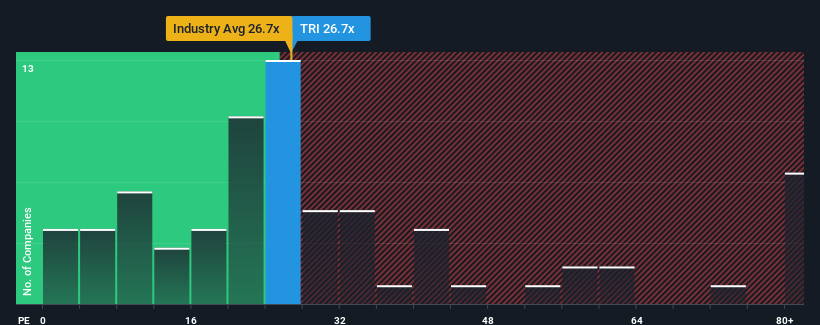- Canada
- /
- Professional Services
- /
- TSX:TRI
Some Shareholders Feeling Restless Over Thomson Reuters Corporation's (TSE:TRI) P/E Ratio

When close to half the companies in Canada have price-to-earnings ratios (or "P/E's") below 13x, you may consider Thomson Reuters Corporation (TSE:TRI) as a stock to avoid entirely with its 26.7x P/E ratio. Although, it's not wise to just take the P/E at face value as there may be an explanation why it's so lofty.
Thomson Reuters certainly has been doing a good job lately as its earnings growth has been positive while most other companies have been seeing their earnings go backwards. The P/E is probably high because investors think the company will continue to navigate the broader market headwinds better than most. If not, then existing shareholders might be a little nervous about the viability of the share price.
Check out our latest analysis for Thomson Reuters

How Is Thomson Reuters' Growth Trending?
Thomson Reuters' P/E ratio would be typical for a company that's expected to deliver very strong growth, and importantly, perform much better than the market.
Taking a look back first, we see that the company grew earnings per share by an impressive 92% last year. The latest three year period has also seen an excellent 144% overall rise in EPS, aided by its short-term performance. Therefore, it's fair to say the earnings growth recently has been superb for the company.
Shifting to the future, estimates from the analysts covering the company suggest earnings growth is heading into negative territory, declining 9.8% per annum over the next three years. Meanwhile, the broader market is forecast to expand by 8.3% per annum, which paints a poor picture.
In light of this, it's alarming that Thomson Reuters' P/E sits above the majority of other companies. It seems most investors are hoping for a turnaround in the company's business prospects, but the analyst cohort is not so confident this will happen. There's a very good chance these shareholders are setting themselves up for future disappointment if the P/E falls to levels more in line with the negative growth outlook.
The Key Takeaway
While the price-to-earnings ratio shouldn't be the defining factor in whether you buy a stock or not, it's quite a capable barometer of earnings expectations.
Our examination of Thomson Reuters' analyst forecasts revealed that its outlook for shrinking earnings isn't impacting its high P/E anywhere near as much as we would have predicted. When we see a poor outlook with earnings heading backwards, we suspect the share price is at risk of declining, sending the high P/E lower. Unless these conditions improve markedly, it's very challenging to accept these prices as being reasonable.
Plus, you should also learn about these 2 warning signs we've spotted with Thomson Reuters (including 1 which shouldn't be ignored).
You might be able to find a better investment than Thomson Reuters. If you want a selection of possible candidates, check out this free list of interesting companies that trade on a low P/E (but have proven they can grow earnings).
Valuation is complex, but we're here to simplify it.
Discover if Thomson Reuters might be undervalued or overvalued with our detailed analysis, featuring fair value estimates, potential risks, dividends, insider trades, and its financial condition.
Access Free AnalysisHave feedback on this article? Concerned about the content? Get in touch with us directly. Alternatively, email editorial-team (at) simplywallst.com.
This article by Simply Wall St is general in nature. We provide commentary based on historical data and analyst forecasts only using an unbiased methodology and our articles are not intended to be financial advice. It does not constitute a recommendation to buy or sell any stock, and does not take account of your objectives, or your financial situation. We aim to bring you long-term focused analysis driven by fundamental data. Note that our analysis may not factor in the latest price-sensitive company announcements or qualitative material. Simply Wall St has no position in any stocks mentioned.
About TSX:TRI
Thomson Reuters
Engages in the provision of business information services in the Americas, Europe, the Middle East, Africa, and the Asia Pacific.
Excellent balance sheet second-rate dividend payer.

